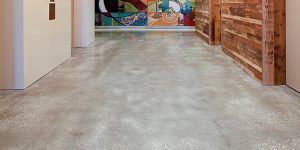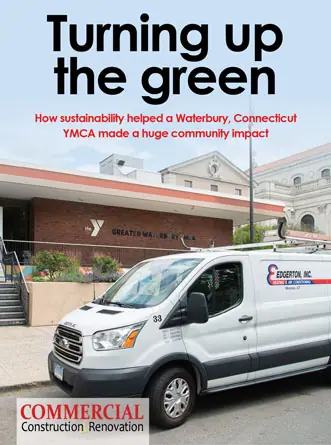 Architects plan for purpose, long-term value and, of course, aesthetics. And, when it comes to flooring, there have never been more solutions to meet these ends available than there are today. The vast range of possibilities can be exciting, but sifting through them can be daunting. From LVT to carpet tile to wood-imitation ceramic tiles, choices abound. In order to deliver the best value to your client, it helps to stay on top of common trends in commercial flooring.
Architects plan for purpose, long-term value and, of course, aesthetics. And, when it comes to flooring, there have never been more solutions to meet these ends available than there are today. The vast range of possibilities can be exciting, but sifting through them can be daunting. From LVT to carpet tile to wood-imitation ceramic tiles, choices abound. In order to deliver the best value to your client, it helps to stay on top of common trends in commercial flooring.
When completed, a building should serve its purpose while fulfilling the client’s aesthetic desires. Finding the best flooring solution comes down three areas: value, sustainability and design.
Why long-term value should guide your flooring decisions
As an architect, budget probably remains top-of-mind as you draw your plans. But it’s wise to keep long-term value in mind as you choose flooring materials. Choosing the cheapest material may save you money in the short-term, but could catch up to you with high maintenance costs. Value, not price, should guide your flooring decisions.
Life cycle costing can show you the long-term costs associated with maintaining different flooring materials, which you can then compare to the upfront price of materials and installation. Knowing the costs and benefits of different solutions will allow you to reduce the costs of flooring installation.
 Keeping on top of trends in flooring is the key to being able to understand the costs and benefits of different flooring options. It might be good, for instance, to know that recently there has been a strong movement away from the 12×12 plank, with many now opting for hexagonal, rectangular and plank-shaped tiles of differing dimensions.
Keeping on top of trends in flooring is the key to being able to understand the costs and benefits of different flooring options. It might be good, for instance, to know that recently there has been a strong movement away from the 12×12 plank, with many now opting for hexagonal, rectangular and plank-shaped tiles of differing dimensions.
Another trending option is digital graphic application, which allows you to make relatively cheap materials – think LVT, porcelain or laminate – look like their pricier counterparts – think stone, marble or wood grain. The versatility and affordability of these design trends allows you to cost-effectively communicate your client’s vision.
For example, a client might think they want hardwood, but due to the high costs associated with material, installation and maintenance, you might be able to cut both short and long-term costs by suggesting LVT designed to look like wood. Your client – and their budget – will be happy, and you’ll have been the one to reconcile the two.
Sustainability: Why green matters
Sustainability and energy-efficiency savings have become standard perks customers look for when completing a project. Beyond the obvious benefits for the environment, integrating energy-efficient materials into your plans can provide sustainability return on investment (SROI) to your client.
For nearly the past decade, U.S. Green Building Council (USGBC) LEED certification requirements have set the standard for green, energy-efficient and sustainable materials. The USGBC’s LEED guidelines shouldn’t be ignored when choosing a flooring solution that works for you and your client — energy-efficiency not only satisfies industry standards, it can also save your client money and improve the overall quality of the facility.
Another way to go green with your plans is to choose reused materials such as reclaimed wood, bio-based tile or other recycled flooring options.
 Designing for form and function
Designing for form and function
As an architect, your job is to transform a client’s vision into a physical reality. To architects, design isn’t an afterthought — it’s part of the process. Balancing aesthetics and purpose, you’ll want to deliver plans that exceed your client’s expectations. From aesthetic elements such as color and pattern, to practical elements that aid in wayfinding, good flooring design welcomes and directs.
You might, for instance, use brightly colored terrazzo to communicate quality in an upscale building. Both form and function matter, however, so you can’t pick a material purely for aesthetics. The patterns of the flooring can help visitors to find their way, and durable materials allow it to withstand heavy use, perhaps even the constant rolling of carts or wheelchairs. It’s accessible, sustainable and low maintenance.
Of course, terrazzo won’t work for every project. Evidence-based design (EBD) will help you choose the right flooring solution for your particular project. This approach draws on industry best practices, allowing your flooring solution to work for you. Using EBD, you can design a building that maximizes noise absorbance and minimizes fall risk, or whatever other benefits you might need to incorporate.
Within the healthcare industry, The Center for Health Design has published a peer-reviewed guide about how EBD can help healthcare facilities improve patient outcomes, for instance. Utilizing EBD can help you build a case to your client about how your design plans will serve them in dollars-and-cents ROI and beyond.
Keeping up with trends in the flooring industry is key to being able to make the best decisions for value, sustainability and design. Form and function matter, but it’s equally important to your client that the project remains within budget. Having the knowledge to guide your client toward the right contract flooring solution for their particular needs is invaluable.
______________________________________________________________
Aaron Hartung is the communications managers at Spectra Contract Flooring, the largest commercial flooring contractor in the United States.







 The 2024 virtual Men’s Round Table will be held Q4, 2024, date TBD.
The 2024 virtual Men’s Round Table will be held Q4, 2024, date TBD.












